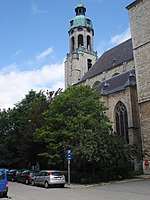St. Michael's Abbey, Antwerp
1795 disestablishments in the Southern NetherlandsBuildings and structures demolished in 1831Christian monasteries in Antwerp ProvinceDemolished buildings and structures in BelgiumFormer buildings and structures in Belgium ... and 2 more
History of AntwerpPremonstratensian monasteries in Belgium

St Michael's Abbey in Antwerp was a Premonstratensian abbey founded in 1124 by Norbert of Xanten and laid waste during the French Revolutionary Wars. In 1807 a semaphore station was installed in the tower of the church. The buildings were demolished in 1831. The abbey has been described as "one of the key churches and most significant monuments in Antwerp from its foundation in the 12th century to its destruction in the nineteenth."
Excerpt from the Wikipedia article St. Michael's Abbey, Antwerp (License: CC BY-SA 3.0, Authors, Images).St. Michael's Abbey, Antwerp
Sint-Michielskaai, Antwerp
Geographical coordinates (GPS) Address Nearby Places Show on map
Geographical coordinates (GPS)
| Latitude | Longitude |
|---|---|
| N 51.215 ° | E 4.3932 ° |
Address
Sint-Michielskaai 19-20
2000 Antwerp (Antwerp)
Antwerp, Belgium
Open on Google Maps






